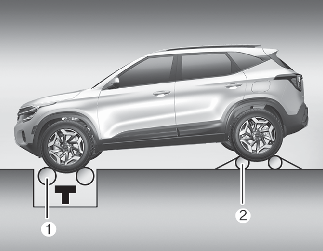For safe All Wheel Drive (AWD) operation

All Wheel Drive
The conditions of on-road or off-road that demand All Wheel Drive means all functions of your vehicle is exposed to extreme stress than under normal road conditions. Slow down and be ready for changes in the composition and traction of the surface under your tires. If you have any doubt about the safety of the conditions you are facing, stop and consider the best way to proceed.
-
Do not try to drive in deep standing water or mud since such conditions can stall your engine and clog your exhaust pipes. Do not drive down steep hills since it requires extreme skill to maintain control of the vehicle.

-
When you are driving up or down hills drive as straight as possible. Use extreme caution in going up or down steep hills, since you may flip your vehicle over depending on the grade, terrain and water/mud conditions.

 WARNING
WARNINGHills
Driving across the contour of steep hills can be extremely dangerous. This danger can come from slight changes in the wheel angle, which can destabilize the vehicle or, even if the vehicle is maintaining stability under power, it can lose that stability if the vehicle stops its forward motion. Your vehicle may roll over without warning and without time for you to correct a mistake that could cause serious injury or death.
-
You must learn how to corner in a AWD vehicle. Do not rely on your experience in conventional FWD vehicles when cornering the vehicle in AWD mode. For starters, you must drive slower in AWD.

All Wheel Drive (AWD)
Reduce speed when you turn corners. The center of gravity of AWD vehicles is higher than that of conventional FWD vehicles, making them more likely to roll over when you turn corners too fast.

Steering wheel
Do not grab the inside of the steering wheel when you are driving on unpaved roads. You may hurt your arm by a sudden steering maneuver or from steering wheel rebound due to impact with objects on the ground. You could lose control of the steering wheel.
-
Always hold the steering wheel firmly when you are driving on unpaved roads.
-
Make sure all passengers are wearing seat belts.
 WARNING
WARNINGWind danger
If you are driving in heavy wind, drive more slowly, as the vehicle's higher center of gravity decreases your steering control capacity.
-
If you need to drive in the water, stop your vehicle, set your transfer to the AWD LOCK mode and drive at less than 5 mph (8 km/h).

Driving through water
Drive slowly. If you are driving too fast in water, the water can get into the engine compartment and wet the ignition system, causing your vehicle to suddenly stop. If this happens and your vehicle is in a tilted position, your vehicle may roll over.

-
Do not drive in water if the level is higher than the bottom of the vehicle.
-
Check your brake condition once you are out of mud or water. Press the brake pedal several times as you move slowly until you feel normal braking forces return.
-
Shorten your scheduled maintenance interval if you drive in offroad conditions, such as sand, mud or water (refer to More Details). Always wash your vehicle thoroughly after off-road use, especially the bottom of the vehicle.
-
Since the driving torque is always applied to the 4 wheels the performance of the AWD vehicle is greatly affected by the condition of the tires. Be sure to equip the vehicle with four tires of the same size and type.
-
A full time All Wheel Drive vehicle cannot be towed by an ordinary tow truck. Make sure that the vehicle is placed on a flat bed truck for moving.

All Wheel Drive (AWD) driving
-
Avoid high cornering speed.
-
Do not make quick steering wheel movements, such as sharp lane changes or fast, sharp turns.
-
The risk of rollover is greatly increased if you lose control of your vehicle at high speed.
-
In a collision, an unbelted person is significantly more likely to die compared to a person wearing a seat belt.
-
Loss of control often occurs if two or more wheels drop off the roadway and the driver over-steers to re-enter the roadway. In the event your vehicle leaves the roadway, do not steer sharply. Instead, slow down before pulling back into the travel lanes.

Mud or snow
If one of the front or rear wheels begins to spin in mud, snow, etc. the vehicle can sometimes be driven out by engaging the accelerator pedal further; however avoid running the engine continuously at high rpm because doing so could damage the AWD system.
Driving in sand or mud
-
Maintain slow and constant speed. Operate the accelerator pedal slowly to ensure safe driving (wheel-slip prevention).
-
Use tire chains driving in mud if necessary.
-
Keep sufficient distance between your vehicle and the vehicle in front of you.
-
Reduce vehicle speed and always check the road condition.
-
Avoid speeding, rapid acceleration, sudden brake applications, and sharp turns to prevent getting stuck.
-
When the vehicle is stuck in snow, sand or mud, the tires may not operate.
-
This is to protect the transmission and not a malfunction.

Moving the car forcibly to get out of mud or sand can cause damage/overheat of the engine or damage/breakdown of the transmission, differential or AWD system as well as damage to tires. If excessive wheel slip occurs after entering a sandy/muddy road, the vehicle may fall into the sand/mud. When this happens, put a stone or a tree branch under the tire, and then try to pull out the car, or try to get it unstuck by repeatedly moving forwards and backwards.

Your vehicle is equipped with tires designed to provide safe riding and handling capability. Do not use tires and wheels that are different in size and type from the originally installed ones. It can affect the safety and performance of your vehicle, which could lead to steering failure or rollover and serious injury. When replacing the tires, be sure to equip all four tires with the tire and wheel of the same size, type, tread, brand and load-carrying capacity.

Jacked vehicle
While the full-time AWD vehicle is being raised on a jack, never start the engine or cause the tires to rotate.
There is the danger that rotating tires touching the ground could cause the jack to go off the vehicle and to jump forward.
-
Full-time AWD vehicles must be tested on a special four wheel chassis dynamometer.
 NOTICE
NOTICENever engage the parking brake while performing these tests.
-
A full-time AWD vehicle should not be tested on a FWD roll tester. If a FWD roll tester must be used, perform the following:

-
Place the front wheels on the roll tester (1) for a speedometer test as shown in the illustration.
-
Release the parking brake.
-
Place the rear wheels on the temporary free roller (2) as shown in the illustration.

Dynamometer testing
Keep away from the front of the vehicle while the vehicle is in gear on the dynamometer. This is very dangerous as the vehicle can jump forward and cause serious injury or death.

-
When lifting up the vehicle, do not operate front and rear wheels separately. All four wheels should be operated.
-
If you need to operate the front wheel and rear wheels when lifting up the vehicle, you should release the parking brake.